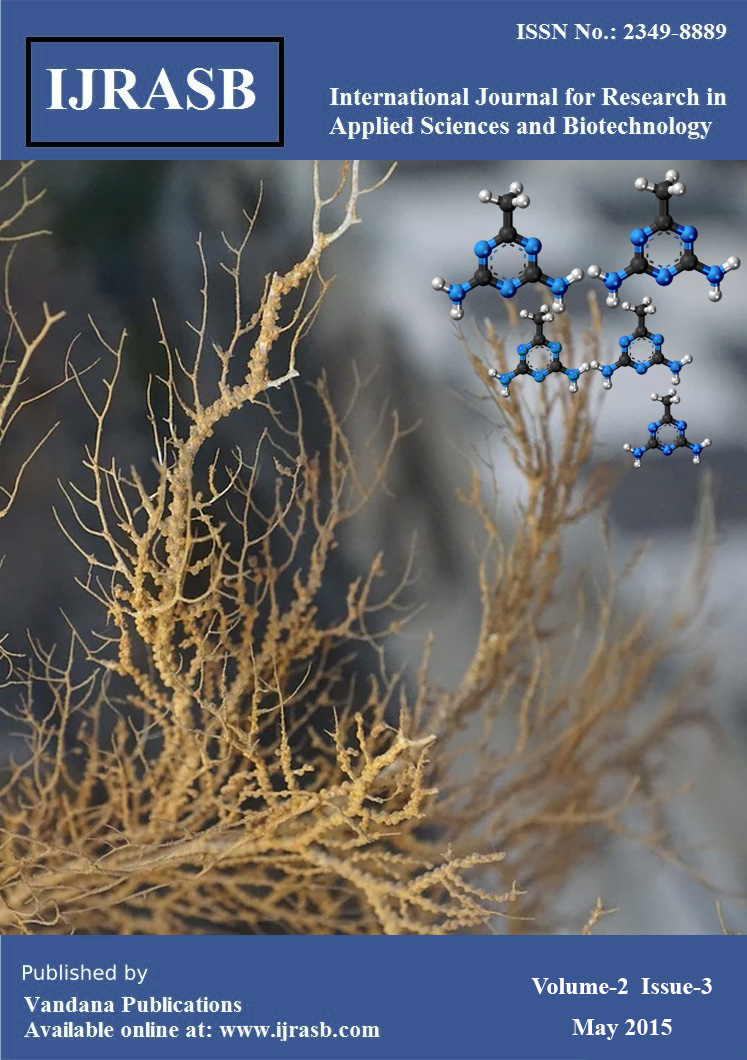Characterization of Plasmid-Encoded Di-benzothiophene and Identification of Conserved Protein
Keywords:
Biodesulfurization, dszABC, Gordonia sp. IITR100, , Nucleotide sequenceAbstract
Biodesulfurization of organosulfur compounds is mediated by activity of the enzymes DszA, DszB and DszC. Here, we report the nucleotide sequence of an 11.5 kb region, containing the dszABC genes along with 3.3 kb upstream and 4.5 kb down-stream region, from a desulfurizing strain Gordonia sp IITR100. The genes are organized together as dszABC in an operon, and their nucleotide sequence is > 99% identical to those from the Gordonia strains IB, RIPI90A & CYKS2. The sequence upstream to dszA, is identical to the reported -1 to -1800 bp from the corresponding region of CYKS2, but presence of two transposase genes was identified in the remaining 2.7 kb region. Sequence of the region downstream to dszC was found to be distinct from all the desulfurizing organisms. BLAST analysis suggested that the cloned 11.5 kb region was possibly formed by crossover between the genomes a Mycobacterium and a Gordonia strain at a site 206 bp downstream to dszC. The results have bearing on understanding the organization and horizontal transfer of the desulfurization genes.
Downloads
References
Ahmad, A., Chauhan, A. K., Kushwaha, H. N., Javed, S., & Kumar, A. Preferential desulfurization of dibenzyl sulfide by an isolated Gordonia sp. IITR100. 3Biotech, 1-7. http://dx.doi.org/10.1007/s13205-014-0221-1
Alves, L., Melo, M., Mendonca, D., Simoes, F., Matos, J., Tenreiro, R., & Girio, F. M. (2007). Sequencing, cloning and expression of the dsz genes required for dibenzothiophene sulfone desulfurization from Gordonia alkanivorans strain 1B. Enzyme and Microbial Technology, 40(6), 1598-1603. http://dx.doi.org/10.1016/j.enzmictec.2006.11.008
Denis-Larose, C., Labbé, D., Bergeron, H., Jones, A. M., Greer, C. W., al-Hawari, J., Grossman, M. J., Sankey, B. M., & Lau, P. C. (1997). Conservation of plasmid-encoded dibenzothiophene desulfurization genes in several rhodococci. Applied and environmental microbiology, 63(7), 2915-2919.
Denome, S. A., Oldfield, C., Nash, L. J., & Young, K. D. (1994). Characterization of the desulfurization genes from Rhodococcus sp. strain IGTS8. Journal of bacteriology, 176(21), 6707-6716.
Furuya, T., Ishii, Y., Noda, K., Kino, K., & Kirimura, K. (2003). Thermophilic biodesulfurization of hydrodesulfurized light gas oils by Mycobacterium phlei WU-F1. FEMS Microbiol Lett, 221(1), 137-142. http://dx.doi.org/ 10.1016/S0378-1097(03)00169-1
Gallagher, J. R., Olson, E. S., & Stanley, D. C. (1993). Microbial desulfurization of dibenzothiophene: a sulfur-specific pathway. FEMS Microbiol Lett, 107(1), 31-35. http://dx.doi.org/10.1111/j.1574-6968.1993.tb05999.x
Grossman, M. J., Lee, M. K., Prince, R. C., Minak-Bernero, V., George, G. N., & Pickering, I. J. (2001). Deep desulfurization of extensively hydrodesulfurized middle distillate oil by Rhodococcus sp. strain ECRD-1. Appl Environ Microbiol, 67(4), 1949-1952. http://dx.doi.org/10.1128/AEM.67.4.1949-1952.2001
Ishii, Y., Konishi, J., Okada, H., Hirasawa, K., Onaka, T., & Suzuki, M. (2000). Operon Structure and Functional Analysis of the Genes Encoding Thermophilic Desulfurizing Enzymes of Paenibacillus sp. A11-2. Biochemical and biophysical research communications,270(1),81-88. http://dx.doi.org/10.1006/bbrc.2000.2370
Kilbane II, J. J., & Robbins, J. (2007). Characterization of the dszABC genes of Gordonia amicalis F. 5.25. 8 and identification of conserved protein and DNA sequences. Applied microbiology and biotechnology, 75(4), 843-851. http://dx.doi.org/10.1007/s00253-007-0895-y
Kirimura, K., Harada, K., Iwasawa, H., Tanaka, T., Iwasaki, Y., Furuya, T., ... Kino, K. (2004). Identification and functional analysis of the genes encoding dibenzothiophene-desulfurizing enzymes from thermophilic bacteria. Applied microbiology and biotechnology, 65(6), 703-713. http://dx.doi.org/10.1007/s00253-004-1652-0
Li, M. Z., Squires, C. H., Monticello, D. J., & Childs, J. D. (1996). Genetic analysis of the dsz promoter and associated regulatory regions of Rhodococcus erythropolis IGTS8. Journal of bacteriology, 178(22), 6409-6418.
Macwan, A. S., Kukshal, V., Srivastava, N., Javed, S., Kumar, A., & Ramachandran, R. (2012). Crystal Structure of the Hexachlorocyclohexane Dehydrochlorinase (LinA-Type2): Mutational Analysis, Thermostability and Enantioselectivity. PloS one, 7(11), e50373. http://dx.doi.org/10.1371/journal.pone.0050373
Mohebali, G., & Ball, A. S. (2008). Biocatalytic desulfurization (BDS) of petrodiesel fuels. Microbiology, 154(8),2169-2183. http://dx.doi.org/10.1099/mic.0.2008/017608-0
Nomura, N., Takada, M., Okada, H., Shinohara, Y., Nakajima-Kambe, T., Nakahara, T., & Uchiyama, H. (2005). Identification and functional analysis of genes required for desulfurization of alkyl dibenzothiophenes of Mycobacterium sp. G3. Journal of bioscience and bioengineering,100(4),398-402. http://dx.doi.org/10.1263/jbb.100.398
Ochman, H., Lawrence, J. G., & Groisman, E. A. (2000). Lateral gene transfer and the nature of bacterial innovation. Nature, 405(6784), 299-304. http://dx.doi.org/10.1038/35012500
Oldfield, C., Pogrebinsky, O., Simmonds, J., Olson, E. S., & Kulpa, C. F. (1997). Elucidation of the metabolic pathway for dibenzothiophene desulphurization by Rhodococcus sp. strain IGTS8 (ATCC 53968). Microbiology, 143(9), 2961-2973. http://dx.doi.org/10.1099/00221287-143-9-2961
Shavandi, M., Sadeghizadeh, M., Khajeh, K., Mohebali, G., & Zomorodipour, A. (2010). Genomic structure and promoter analysis of the dsz operon for dibenzothiophene biodesulfurization from Gordonia alkanivorans RIPI90A. Applied microbiology and biotechnology, 87(4), 1455-1461. http://dx.doi.org/10.1007/s00253-010-2605-4
Yano, H., Miyakoshi, M., Ohshima, K., Tabata, M., Nagata, Y., Hattori, M., & Tsuda, M. (2010). Complete nucleotide sequence of TOL plasmid pDK1 provides evidence for evolutionary history of IncP-7 catabolic plasmids. Journal of bacteriology, 192(17), 4337-4347. http://dx.doi.org/10.1128/JB.00359-10
Yu, B., Xu, P., Shi, Q., & Ma, C. (2006). Deep desulfurization of diesel oil and crude oils by a newly isolated Rhodococcus erythropolis strain. Applied and environmental microbiology, 72(1), 54-58. http://dx.doi.org/10.1128/AEM.72.1.54-58.2006
Downloads
Published
How to Cite
Issue
Section
License

This work is licensed under a Creative Commons Attribution-NonCommercial-NoDerivatives 4.0 International License.








